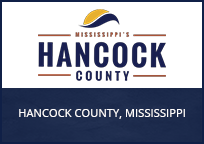Hancock County Point Cloud City

Hancock County
Indoor mapping is the next big frontier for the geospatial field. Lack of adequate indoor maps is a well-documented public safety issue reasserted with each building fire, earthquake, mass shooting, and other tragedies. While technology exists capable of mapping buildings, very few standards and best practices are available to create reliable, affordable, and consistent indoor maps. Listen to the three award recipients tasked with addressing point cloud indoor mapping.
Quick Resources
Project Overview
Hancock County is the southern-most county in Mississippi located on the Gulf Coast. The County has a population around 44,000 and is a USDA-designated Rural Area. The cities of Bay Saint Louis, Waveland, Diamondhead, Kiln, and Pearlington are the cities in the area. The NASA Stennis Space Center, a federal city, makes up one quarter of the County hosting over 30 federal agencies and 5,000 employees.
Hancock County is known nationwide in the Public Safety community because of its handling of Hurricane Katrina and the Deepwater Horizon Oil Disaster by its long-standing Emergency Management Agency Director, Brian Adam. Mr. Adam routinely speaks at conferences on the County’s experience and lessons-learned facing unprecedented disasters. The County’s geography, federal presence, and university infrastructure have made it a hotbed for geospatial innovation especially within the public safety arena.
The County hosts an US Small Business Administration Regional Innovation Cluster called the Enterprise for Innovative Geospatial Solutions (EIGS). The County also hosts a business cluster for unmanned remote sensing vehicles called Unmanned Coast. Hancock County engaged two geospatial companies, NVision Solutions Inc. and Teledyne Optech, who are members of these R&D organizations for this Point Cloud City grant proposal.
Hancock County has extensive experience in managing federally-funded projects including grants. As a rural area, Hancock County is often selected for pilot projects as a lowest-common-denominator for proof of concepts. Projects which succeed here with a low population and limited infrastructure compared to more urban areas, provide proof that a given concept can be implemented anywhere in America.
Hancock County has been continuously populated with cities for 300 years. The County features historical buildings as well as recently-built modern architecture constructed after Hurricane Katrina. The diversity of the County’s buildings provide an excellent sampling for research datasets.
NVision Solutions Inc will provide geospatial software licenses and workstations needed to analyze data and produce products for this project by the Hancock County team.
Teledyne Optech will loan an Optech Maverick mobile mapping system to Hancock County for approximately 3–4 days per month on average over the year of the project. When the system is not being used, it will be returned to Teledyne Optech. Teledyne Optech, Hancock County and NVision will determine a mutually agreeable schedule for the loan in order to maximize the usage of the system and minimize the amount of shipping required.
View the award press release to read more about the Point Cloud City funding opportunity.
<< Back to the PSIAP - Point Cloud City Page
* As a service to the research community, NIST provides the links to the datasets created by financial assistance recipients that received awards under the NIST Public Safety Innovation Accelerator Program – Point Cloud City Notice of Funding Opportunity. NIST had no role in the creation of the datasets other than to fund these awards. NIST makes these datasets available “AS-IS” and provides no warranties, express or implied, of merchantability or fitness for a particular purpose. NIST makes no representations that the use of the datasets will not infringe any patent or proprietary rights of third parties. Providing a link to these datasets does not constitute a NIST endorsement of the third-party institutions involved. NIST makes no representations about the quality, reliability, or any other characteristic of the datasets.

